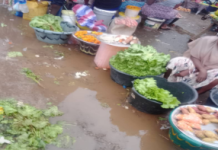New Dawn For The Gambia
NDMA, Sitrep Give Situation Reports
with Madiba Sinhateh
Welcome to another edition of the Environment Column and in this edition, we will profile and comment on the unprecedented devastating floods of 30th and 31st July 2022, which directly affected over 40,000 people according to reports from the National Disaster Management Agency (NDMA), rendering them homeless. We will also bring excerpts of an interview we had with the NAM for Serekunda and Councilor for London Corner Ward.
Since the July flash floods hit the country, many people questioned whether seasonal floods and inundation has become the new phenomenon for the Gambia.
Some people even express fear when the sky begins to darken, because they have nowhere to lay their heads.
According to Officials of the Meteorology Department, this year’s seasonal rains brought the heaviest downpour that the country has ever recorded in more than thirty years.
In the same development, the National Disaster Management Agency indicated in their Situation Report that 40,501 people have been affected from the July 30th/31st heavy rainfall. That out of this number of affected people 8,436 are children whilst 2,609 are pregnant and lactating women.
According to the NDMA’s Situation Report, “hundreds of thousands of people in the Gambia are negatively impacted by the recent floods.”
The report further indicated that a GIS specialist will be mapping out the affected areas and register the impact of the floods on the population.
However, the report said ongoing registration has identified 40, 501 people who have been directly affected by the recent heavy downpours, with the suburbs of urban settlements being the hardest hit by the recent floods. The report said eleven people loss their lives, and that children under five years of age, account for 22% of the affected population, while females account for 51%. The report further indicated that 2,446 pregnant and lactating women were recorded among the flood victims, together with 1,756 persons with disabilities.
Another situation report on the recent floods was the ‘Sitrep’ Report.
According to ‘Sitrep’, the cause of the unprecedented flood disaster can be linked to the unfriendly environmental activities such as the indescriminate and irregular dumping of all type of waste, together with the building of houses and dwelling places on waterways.
“In many of the affected communities, it is realized that the outlets for sewage and water was blocked as a result of the indiscriminate disposal of waste in gutters.
“Furthermore, many houses have been built on waterways thereby affecting the free and uninterrupted flow of water, towards the sea or other water catchment bodies. Unfortunately, during such heavy rains, many households dispose of their waste in the running flood waters thereby causing the blockage of all the canals meant for water evacuation, because many of the affected areas in these communities live along swampy areas or water ways,” the ‘Sitrep’ report states.
The report further commented on Government’s immediate response to the flood disaster, siting the Vice presidents and Cabinet Minister visiting flood victims in Banjul, where tens of people were affected, together with the destruction of their valuable personal and household properties, whilst in some parts of the country, lives were lost.
“The July 30th and 31st flash floods were the worst that have hit the Gambia in nearly half a century. The torrential rain associated with thunderstorms resulted to flash flooding which affected the entire country” the ‘Sitrep’ report concludes.
In Banjul, the city’s $40 million road expansion project came under strong and heavy criticism when homes in the capital became flooded, and many raised questions concerning the inefficiency of such a project in water evacuation.
According to the ‘Sitrep’ report, Banjul is below seas level and is very prone to such climate disasters like floods. The report further gave examples that when it is high tide, water from the seas flows in some compounds.
In Banjul, Vice President Alieu Badara Joof promised relocation for some of the victims affected.
President Adama Barrow also visited the flood victims and promised that an $80 million dollar canal project is in the pipeline in the nearest future, that will curb such situations for good.
In the Kanifing Municipality, this Columnist spoke to Musa Cham, the NAM for Serekunda. According to Cham, he has recently been in contact with the responsible authorities in order for them to come and do a survey as to what is the main cause of the flooding in his area which has been going on for so many years now.
“It is not something that is unknown to the Government and therefore, it is about time and for any responsible Government to come on the ground and do a survey in order to provide a lasting solution for the people,” Cham said.
He said the main solution to the problem is the planned canal for water evacuation which he said should be well designed in such a way that flood water will flow easily and out to the ocean. He suggests for a survey to be carried out from the beginning of the canal at Abuko to mouth where it will empty into the ocean, where he said people have encroached the water passage way.
Cham said he has also called on the Red Cross and National Disaster Management officials for them to come and assess the damages in his area in particular, but the entire country in general.
A resident of London Corner in Serre Kunda who goes by the name Sulayman, said they are exhausted with their situation and cautioned that if the rains continue to be heavy without any proper drainage, many more will be flooded and many more properties will be destroyed.
Sulayman suggests that since the floods are becoming persistent every rainy season, Government should come up with a lasting solution by building a solid water canal such as the one behind them in London Corner.
Sulayman like many others, said he lost both personal and household properties.
In Banjul, one victim was seen carrying his flat screen television on his head saying he cannot afford to lose his TV which costs over thirty thousand dalasi or nearly 700-800 euros.
Aji Saptiue Jaye, the Councillor for London Corner Ward said the flood has destroyed lots of properties including food items, bedding, furniture, etc.
According to her, the cause of the flooding is the Bakoteh Bridge which has two main holes as water passage ways; that the capacity of the water was too much for the bridge that everything could not pass through, and has to flood people’s homes.
Aji Saptieu concludes that the flood water was not from London Corner alone but was from Mandinari via Abuko and Borehole, before passing through London to Dippa Kunda, joining the stream at Manjai and then to the Ocean.





















